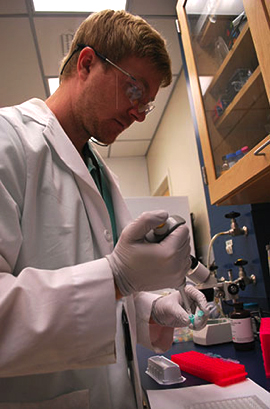- Home >
- Meet a Program Fellow >
- Matthew Coppock

Matthew Coppock, Ph.D., researches the use of peptide fragments to detect hazardous biological agents, as a part of the U.S. Army Research Laboratory Post-Doctoral Research Program, in Adelphi, Md.
Matthew Coppock’s family has a long history of service to the U.S. Department of Defense. His father and both grandfathers were active duty soldiers, and two uncles work for the Navy and the Marine Corps Exchange. Needless to say, Coppock felt drawn to serve and protect his country, but through different means – research involving a unique biochemical detection technology which helps the Army identify hazardous biological agents.
After completing his doctoral degree in chemistry at Pennsylvania State University, Coppock applied to and was selected for a research position within the U.S. Army Research Laboratory (ARL). The ARL hosts a Post-Doctoral Research Program, which is administered by ORAU through a contract with the U.S. Department of Energy to manage the Oak Ridge Institute for Science and Education. The ARL fellowship program is designed to significantly increase the involvement of creative and highly trained scientists and engineers from academia and industry in scientific and technical areas of interest and relevance to the Army.
One such area is the continued threat our country faces from biological warfare agents, which include infectious microorganisms such as bacteria, viruses or fungi developed with the intent to harm or kill humans. Examples include anthrax, smallpox virus or even bubonic plague. Because these microorganisms are often invisible to the naked eye, they can be difficult to detect.
The typical method used to test for the presence of a harmful biological agent involves antibodies. Every time the human body is exposed to a foreign microorganism, it develops an antibody, or a protein that the immune system uses to fight off the foreign object. Antibodies bind only to the foreign object they target. Researchers can create antibodies in a laboratory setting, but they are not very stable outside of a controlled environment and can take up to 6 months to make a small amount.
An alternative method to detect biological hazards is the Protein Catalyzed Capture Agent (PCC) biodetection technology, first invented by the Jim Heath Laboratory at the California Institute of Technology. It involves the use of peptides, which are the building blocks of natural antibodies. Coppock has been able to further the PCC technology at the ARL site in Adelphi, Md., with his mentor Amethist Finch, Ph.D.
PCC agents offer superior stability, lower cost and faster creation compared to laboratory synthesized antibodies, through a method called “click” chemistry. Coppock explained, “In PCC technology, there are two peptides, and each has a different “click handle” or area where the peptides can permanently join together. When the two peptides recognize a surface protein of the biohazard, and are in the correct orientation to one another, the two complementary “click handles” will “click” together to create a single PCC detection molecule.”
Coppock’s research with PCC technology is only involved in creating the component that “captures” the threat, which is a single but critical part of the whole detection process. This capture component ideally can be incorporated into any biological detection device, such as test strips, electrochemical detectors or another similar platform in place of antibodies.
“If the challenge of performance in environments outside the laboratory can be overcome, this will be a major breakthrough in antibody and capture agent technology,” Coppock stated.
Coppock said the most valuable part of the ARL Research Associateship Program has been the ability to expand his scientific knowledge and collaborate with other researchers who work on similar biosensing projects. He has attended several national conferences where he was able to present his research.
“I entered the program as a chemist, having very little background in biological applications,” he said. “With my research, I have been able to broaden my scope outside of strictly chemistry, and I feel very confident that the experience I gain from participating in this program will make me a sought-after candidate in the job market.”
After completing the program, Coppock hopes to continue to push the limits of biological sensing technology and move into a full-time research position where he can further pursue topics that have immediate applications for human health and safety.
